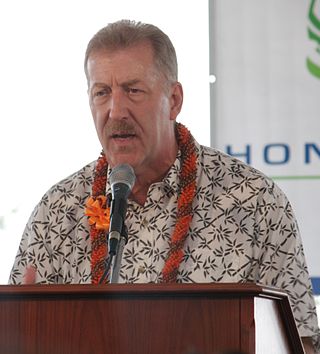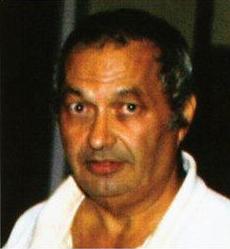
Andrea Pia Yates is an American woman from Houston, Texas, who confessed to drowning her five children in their bathtub on June 20, 2001. The case of Yates—who had exhibited severe postpartum depression, postpartum psychosis, and schizophrenia leading up to the murders—placed the M'Naghten rules, along with the irresistible impulse test for sanity, under close public scrutiny in the United States.
The Honolulu Advertiser was a daily newspaper published in Honolulu, Hawaii. At the time publication ceased on June 6, 2010, it was the largest daily newspaper in Hawaii. It published daily with special Sunday and Internet editions.

Frank Francis Fasi was an American politician who was the longest-serving Mayor of Honolulu, Hawaii, serving for 22 years. He also served as a territorial senator and member of the Honolulu City Council. To date, he remains the last Republican Mayor of Honolulu.

Peter Benson Carlisle is an American politician and attorney who served as the 13th Mayor of Honolulu, Hawaii from 2010 to 2013. Prior to serving as interim Mayor following the resignation of former Honolulu Mayor Mufi Hannemann, Carlisle had served as the Prosecuting Attorney of Honolulu from 1996 to 2010.
Galen Fox is a former Hawaii State Representative of the Republican Party who resigned from the Hawaii legislature on December 1, 2005, after being convicted of misdemeanor sex abuse charges.

Noshir Sheriarji Gowadia is a former design engineer and convicted spy for several countries. He was arrested in 2005 and later convicted on industrial espionage-related federal charges.
The Pearl High School shooting occurred on October 1, 1997 at Pearl High School in Pearl, Mississippi, United States. The gunman, 16-year-old 11th grade student Luke Woodham, shot and killed two students and injured seven others at the school after killing his mother by bludgeoning at their home earlier that morning.
Halawa Correctional Facility is a state prison in the City and County of Honolulu, Hawaii on the island of Oahu. It is operated by the Hawaii Department of Public Safety. The prison is in proximity to the communities of Aiea and Halawa.
Michael Mark Welner is an American forensic psychiatrist and Chairman of The Forensic Panel. Welner is best known for his work in sensitive and complex litigation. He has acted as lead forensic psychiatric examiner in numerous criminal or court proceedings of national and international prominence, including precedent-setting trials and higher court decisions. Welner is also known for a number of innovations in forensic science, forensic psychiatry and justice, including protocols for prospective peer review in forensic medicine consultation, research to standardize an evidence-based distinction of the worst crimes, The Depravity Standard, and recommendations for upgrading forensic science assessment. He has been featured in network television news coverage of forensic psychiatry issues, has authored publications for professional and public audiences, and has contributed to emerging legislation on mental health reform.
Kirk Matthew Lankford is an American from Kalihi, Hawaii who was convicted of murdering a Japanese tourist in Pūpūkea, Hawaii.

Samuel Pailthorpe King was an American lawyer and judge. He served as a United States district judge of the United States District Court for the District of Hawaii.

In 2008, two attempts were made by separate groups involved in the Hawaiian sovereignty movement to occupy ʻIolani Palace, the home of the last two monarchs of the Hawaiian Kingdom in downtown Honolulu in the U.S. state of Hawaii.
Robert Gordon Klein is a former justice of the Supreme Court of Hawaii from March 31, 1992, to February 4, 2000. He was appointed by governor John Waihee. He left office 8 years into his 10-year term to join a private firm. He is part Hawaiian.

Mark Prever Robinson was a Hawaiian business magnate and politician. He served as Minister of Foreign Affairs of the Kingdom of Hawaii under the reign of Liliuokalani. During times of political upheaval and financial stress of Hawaii's changing governments, Robinson joined with other business men to come to the financial aid of the government.
David C. Schutter (1940-2005) was a Honolulu criminal defense attorney and civil litigator. He was noted for his flamboyant courtroom persona and involvement in high-profile legal cases in Hawaii during the 1970s and 1980s.
Charles Marsland (1923-2007) was a Honolulu attorney who served as the first elected Prosecuting Attorney of Honolulu from 1981 to 1988. He is best known for his aggressive prosecution of the Hawaiian Mob during the mid 1980s, which took place after the murder of his son that was allegedly connected to organized crime.

William Everett Woods was an American gay rights activist. He advocated for better treatment of gay people through his political organizing and public commentary. In 1990, he took three same-sex couples to fill out marriage licenses, beginning the series of events that would lead to the legalization of same-sex marriage in the United States.

Robert Mark Edwards is an American murderer who killed two female realtors in sexually-motivated murders, one in California in 1986 and another in Hawaii in 1993. In separate trials, he was sentenced to death and to life imprisonment in the respective states and is currently awaiting execution at the San Quentin State Prison.

Eugene Walter Barrett was an American serial killer who murdered three women he was romantically involved with in Honolulu, Hawaii from 1959 to 1995. He was sentenced to life imprisonment for the final murder and died in prison in 2003. He was the first confirmed and one of only three known serial killers active in the state, the others being the unidentified Honolulu Strangler and the Kauai serial killer.
Adriano Domingo was the final civilian executed by the Territory of Hawaii prior to their abolition of the death penalty in 1957. Domingo was sentenced to death and hanged for the murder of Helen R. Sakamoto, a 21-year-old secretary, in Kauai on August 3, 1943. Although Domingo's execution made him the final civilian executed by the Territory of Hawaii, there were several executions that took place there during and after World War II for military crimes, some of which were not committed in Hawaii.










